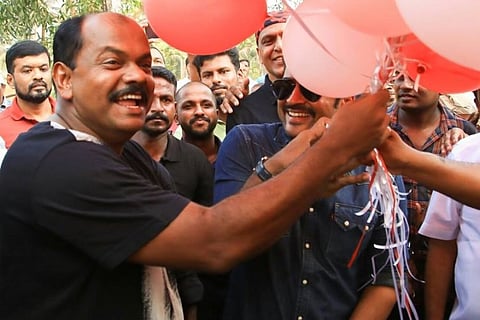

He is known for teasing out issues that are considered taboo in Kerala through his cinema. When Notebook released, suddenly everyone was talking about teenage love, pregnancy and mental health.
Eight films young, Rosshan Andrrews is gearing up for his next release - Kayamkulam Kochunni. Here’s a quick look at his thoughts and approach to the craft.
Did you first read about Kayamkulam Kochunni from Amar Chitra Katha?
I read it on the same day from Amar Chitra Katha and Aithihyamala, which is more detailed. I really wanted to do a historic film and it was Sanjay (from the Bobby-Sanjay duo) who asked me to read the book. It’s originally just a small story.
What fascinated you about this young Robin Hood?
I didn’t know he had a temple in his name (in Pathanamthitta district). Imagine a temple in the name of a Muslim and that too a thief. We will be focusing on his life before he became a legend—the young man with big dreams, his love story, living in a society riddled with casteism.
Was Nivin the first choice?
Yes. We wanted an actor who could pull off the transition from a young lad to this unlawful bandit and we didn’t need to look beyond Nivin. He is a director’s actor who can reproduce a character in all its beauty.
Have you employed any dialect for Kochunni?
Not really. We thought that may kill the viewing pleasure. It has been told as simply as it would be by a boy who reads Amar Chitra Katha.
As a director what was the biggest challenge this film posed for you?
Personally, my challenge was giving life to a script. A scriptwriter might just write about a man and woman living in a flat, but the details are filled in by a director. Similarly, in this film set in 1830, with very few reference points, it’s up to me to recreate that era for a frame. In a scene where Kochunni and Janaki are taking a stroll in the market, we had to bring in 100-200 boats carrying goods, animals, bullock carts, donkeys, British officers, show the prevalent caste system and everything is encapsulated in one shot.
Historical films are known for its large crowds too…
Yes, but then I read that the population was in fact less in 1830. There were more animals and less people. We could manage within the constraints of our 45-crore budget.
What was the point of reference?
The story is 150 years old. And the only reference point was this Malabar Manual book, so we put three people in the research team. Kochunni’s hideout Vavvakkayu is still there; even the house where he smeared lime on the walls. We have reproduced all the props.
Mohanlal agreed immediately for the cameo role?
I told him over the phone and he immediately agreed. He was gracious enough to play a cameo in a Nivin Pauly film. For some reason he likes me a lot (chuckles). Ithikkara Pakki was a Robin Hood himself, who would hurtle effortlessly between trees.
Your association with Bobby-Sanjay have been extremely fruitful so far. What’s the secret?
I would like to quote Sanjay who said they have many seedlings with them and it might grow anywhere but it grows more fruitfully in Rosshan’s land. They know I will not bring their script down.
This is your 9th film and it has been 15 years, was this break between films deliberate?
I had promised to be with my wife after she delivers our first-born. We had two more and I wanted to watch them grow. I also wanted to study cinema. Since I take good money, it helps me to tide over. I always believed in quality not quantity.
Your films have always addressed issues; teenage pregnancy, importance of organic farming, homophobia, gender inequality in marriages, parental neglect and educational methods in schools...
It’s always important to inspire your audience. I want to give them the best version of Rosshan Andrrews. It’s all about making a film I want to see. There is nothing called perfect art.
Is there a difference between directing stars and non-stars?
For me, they are just actors or my characters. All I am wondering is how to prepare them to be that character. In the dubbing studio even their breath is in my control. I love the process. I first try to gauge their true personalities—meet and talk, note their moods, body language, conflicts and then bring them into their characters. We have a 15-day camp where we get to know them closely.
How do you tick all boxes when you make a film?
I don’t think like that. You just need to be honest to your craft, tell a story beautifully and organically. I really don’t know what every person in the theatre wants but I know what I want–I should enjoy it, then I can expect others to do so. You can hate it or love it but you can’t ignore it.
Your thoughts on social media?
It’s something I have mentioned through Manju Warrier’s character in How Old Are You? A lot of faceless activists who are afraid to say anything to your face. They should be ignored. If used positively, it’s good (like the recent floods in Kerala).
Any recent films you really loved watching?
Sudani from Nigeria, Maheshinte Prathikaram. I watch out for the directors and writers—loved Dileesh Pothan, Martin Prakkat, Abrid Shine, Alphonse Puthren—they are radical in their thought and approach.